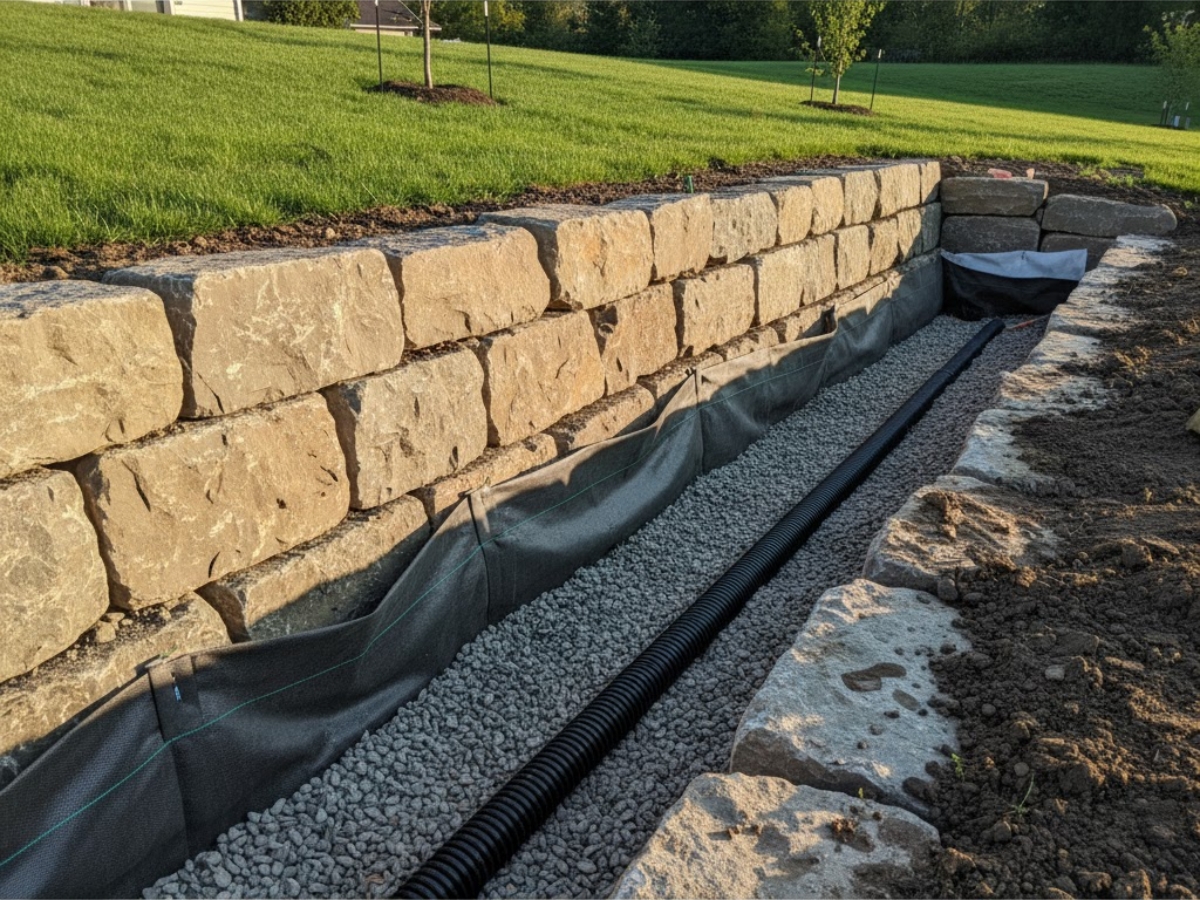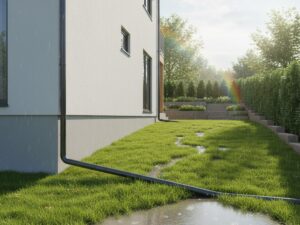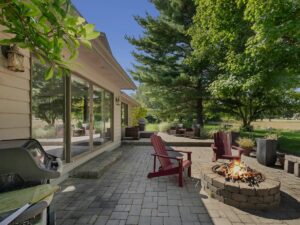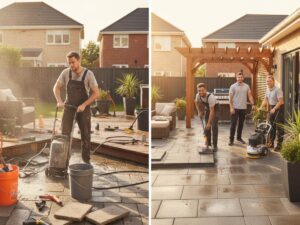Retaining walls play a critical role in holding back soil, preventing erosion, and stabilizing slopes. However, even the strongest walls can fail if water is not properly managed. Without effective drainage, buried water generates hydrostatic pressure that can crack, bulge, or collapse a wall. Indeed, improper drainage is often cited as the leading cause of retaining wall failure, with saturated soils capable of more than doubling lateral pressure. To prevent this, designers install drainage solutions to channel water safely away.
In this blog, we’ll break down these retaining wall drainage solutions and guide you on how to implement them correctly, helping you build a durable, long-lasting retaining wall without the common struggles.
What Is Retaining Wall Drainage?
Retaining wall drainage setup refers to the system designed to control and redirect water that builds up behind a retaining wall. When rainwater or groundwater seeps into the soil, it increases hydrostatic pressure, one of the main causes of wall failure. Proper drainage ensures this water is collected and discharged safely, maintaining the wall’s structural integrity. Typical drainage systems include perforated drain pipes (often called “ag pipes”), gravel or crushed rock backfill to allow free water movement, filter fabric to prevent soil clogging, and weep holes for surface water release. Without these measures, moisture accumulation can lead to soil expansion, cracking, tilting, or even collapse.
Significance of a Well-Built Retaining Wall Drainage System
Reduction of Hydrostatic Pressure
Hydrostatic pressure behind a retaining wall increases with the depth of water, and in many cases can double or even triple the lateral load that the wall was designed to resist. A proper retaining wall drainage, including perforated drain pipes, weep holes, and free-draining backfill, allows water to escape and prevents its buildup, thus keeping the pressure within safe limits.
Prevention of Soil Saturation and Related Soil Behavior Problems
Poor drainage means that water saturates the backfill soil. Saturated soil becomes heavier, reduces shear strength, loses cohesion (particularly clayey soils), and may even behave in a more fluid or “liquid-like” fashion under certain conditions (e.g. after heavy rain). Saturation can also increase the tendency for freeze-thaw damage in colder climates (if applicable) or swelling and shrinking in expansive soils. Good retention wall drainage keeps moisture content in the soil at safer levels, preserving effective soil mechanics.
Enhanced Structural Stability and Lifespan
By keeping both hydrostatic pressure and soil saturation under control, the structure is under less stress overall. Less stress means fewer cracks, less tilting, and less risk of bulging or displacement. Over time, the reduction in these stresses significantly increases the wall’s service life. Also, materials like concrete, masonry, wood, or block can degrade if they are regularly exposed to high moisture levels; draining helps avoid these issues like freeze/thaw damage, mold, rot, or rust (depending on material), contributing to retaining wall safety & durability.
Minimized Soil Erosion and Landscape Damage
When water cannot escape, it often finds weak paths/crevices and escapes through the walls, carrying soil particles with it. This leads to erosion behind or around the wall, loss of backfill material, voids, and possible undermining of the wall’s base. Good drainage (plus filter fabric to stop soil infiltration into drainage media) helps prevent this. It also helps prevent surface runoff from above the wall to not erode the back or crest of the wall. Controlled drainage preserves the landscape and soil structure around the wall.
Compliance with Standards and Safer Design Margins
In the United States, several engineering standards and codes require proper drainage design as a critical component of retaining wall construction. The American Concrete Institute (ACI 318 – Building Code Requirements for Structural Concrete) and the Federal Highway Administration (FHWA) Design Manual for Retaining Walls (NHI-10-024) both emphasize the need for drainage systems to reduce hydrostatic pressure and improve wall performance. Additionally, the International Building Code (IBC 2021, Section 1807) mandates provisions for drainage behind earth-retaining structures to ensure stability and durability. Compliance with these standards ensures that the wall maintains appropriate safety factors for soil and water pressures, protecting both retaining wall contractors and property owners from structural failures, liability issues, and costly repairs.
Drainage Solutions for Retaining Walls
Perforated Pipe Systems (French Drains)
Perforated pipes, often referred to as French drains, are essential for subsurface drainage behind retaining walls. These pipes are typically made of 4-inch PVC or HDPE and are laid at the base of the wall, surrounded by clean, angular gravel. The perforations allow water to enter the pipe, which then redirects it away from the wall, preventing hydrostatic pressure buildup. A minimum slope of 1–2% is recommended to ensure effective water flow.
Drainage Aggregate (Gravel Backfill)
A layer of free-draining material, such as clean, angular gravel or crushed stone, is placed behind the retaining wall. This retaining wall drainage aggregate facilitates the movement of water towards the perforated pipe system. The gravel should be well-graded to maximize void space and minimize clogging. A minimum thickness of one foot is recommended, increasing with wall height.
Weep Holes
Weep holes are strategically placed openings in the retaining wall that allow water to escape from behind the structure. They are typically spaced 6 to 10 feet apart, depending on the wall’s height and design. The diameter of weep holes usually ranges from 2 to 4 inches. To prevent soil from migrating, weep holes are often paired with geotextile filters, making them a crucial component of any retaining wall and drainage strategy.
Geocomposite Drainage Panels
Geocomposite Drainage Panels are engineered solutions that combine a permeable filter fabric with a rigid or semi-rigid drainage core, allowing water to move efficiently behind retaining walls. They are especially valuable in areas with limited space or challenging soil conditions where traditional gravel and pipe systems may be impractical. These panels manage high volumes of water, prevent soil migration into the drainage system, and are chemically resistant to various soil types.
Backfill Compaction and Layering
Proper backfilling involves placing soil or other material behind the retaining wall in layers, each compacted to eliminate air pockets. This process ensures that the drainage system remains intact and functions effectively. The levels of gravel around the pipes and weep holes must be uniform to maintain consistent water flow.
Outlet Placement and Maintenance
The drainage system should direct water to a safe location, such as a storm drain or a designated lower area. Regular inspections of retaining wall drainage systems are essential to ensure that the system continues to function properly. Cleaning debris and mud from weep holes and drainage pipes will allow water to escape from behind the wall and prevent pressure buildup.
Conclusion
Expert design and professional retaining wall drainage installation are essential to prevent water damage, soil erosion, and structural failure of any retaining wall. So, don’t risk your retaining wall’s stability with improper drainage; get help from an expert retaining wall and paver installation contractor today. At My Landscape Contractor, we not only provide customized retaining wall drainage solutions but also offer landscaping, hardscaping, garden design, and outdoor construction services.




